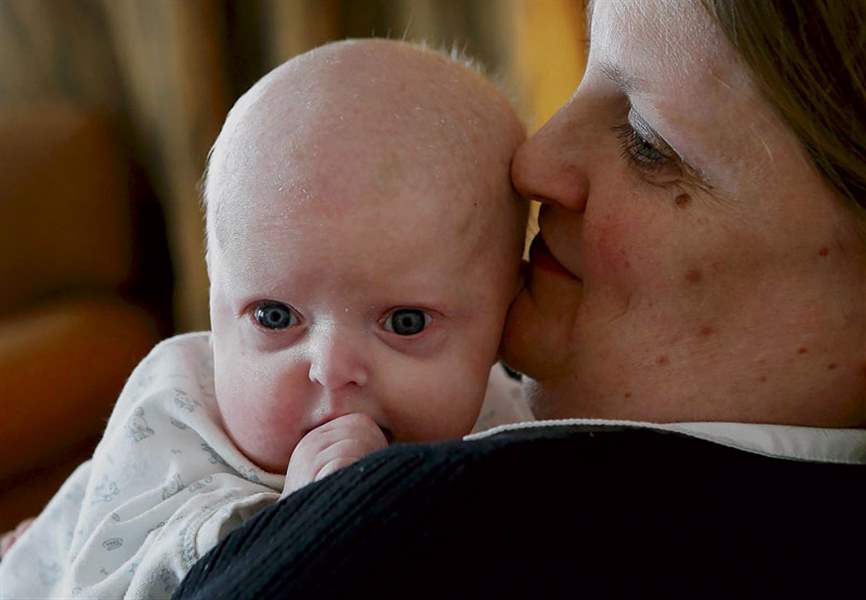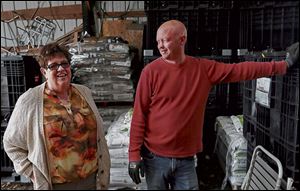
A cure is on the way ...
... for babies who can’t grow hair or teeth
4/28/2014
Sarah Yaroch of Waterford, Mich., holds her 5-week-old son, Andrew, who has a rare genetic disorder that prohibits growth of teeth and hair.
St. Louis Post-Dispatch

Sarah Yaroch of Waterford, Mich., holds her 5-week-old son, Andrew, who has a rare genetic disorder that prohibits growth of teeth and hair.
ST. LOUIS — When Mary Kaye Richter’s son was diagnosed, she could only find a few paragraphs about hypohidrotic ectodermal dysplasia, which inhibits the growth of teeth, hair, and sweat glands.
To learn more, she converted a storage room of a church in Mascoutah, Ill., into the headquarters for a foundation that she established.
Now 33 years later, Richter’s life’s work came full circle when she got the chance to meet month-old baby Andrew with the same genetic disorder. His family flew to St. Louis from Michigan last month to test a therapy that could be a cure.
When Richter, 69, saw the baby asleep in his mother’s arms in their St. Louis Children’s Hospital room, she was overcome. “Excuse me everybody, there’s something I have to do,” she said.
She placed her hand on the baby’s head. And she prayed.
“What is the likelihood of a southwestern Illinois farm wife bringing all this attention to a condition where in 30 years you are talking about a treatment?” she said. “It was one of those moments that shouted for prayer.”
Richter gave thanks for the thousands of parents across the world — joined by the foundation — who raised funds for research and provided information and testing subjects for scientists. She gave thanks for Andrew’s parents, Robert and Sarah Yaroch, whose baby is just the third in the world to test the protein therapy. If it works, the therapy would be first to permanently correct the effects of a genetic mutation.
It all started with Richter’s effort to write letters to dental schools across the country, asking if they had seen children with this condition, so she could find other parents. Richter quickly learned that estimates of fewer than a dozen people in the U.S. having this disorder were wrong.
“My desire to find a family to help us turned into something I never would’ve imagined,” she said. “I kept hearing, ‘Somebody has got to do something to help these kids.’”
Richter wasn’t sure why her baby Charlie got so fussy in the summer heat. When he was a year old and still had no teeth, her dentist told her not to be concerned until he was 18 months.
When he reached 16 months old, however, she couldn't wait. She took him in for X-rays, and they came back blank. Luckily, her dentist was aware of the disorder and broke the news to her.

Mary Kaye Richter, founder of the National Foundation for Ectodermal Dysplasis, visits with her son, Chuck.
"I remember walking out of that office, holding [Charlie] so tight, as if I was going to protect him from everything that would come along," she said.
Her pediatrician searched medical libraries for information, only to find half a dozen paragraphs in periodicals. Finding other parents was the only way she was going to learn how to best care for her baby.
A newsletter for the parents discovered through her letters to dental schools was the first step. They shared information on everything from the importance of getting dentures early to whether the children could play sports. Parents offered tips on how to deal with insurance or care for dry eyes and noses. They alleviated one another's fears about the children's intellect or how long they would live.
But Richter felt they needed to do more.
"Two things became clear, Richter said. "We had to help kids get care whose families couldn't afford it, and we had to try to stimulate some research."
She founded the National Foundation for Ectodermal Dysplasis in 1981. Families provided blood samples to Dr. Jonathan Zonana, an Oregon Health and Science University researcher who was able to locate the gene associated with the disorder. They held walks, barbecues and mass mailings to raise funds for Zonana to continue his research, which helped him win large government grants over the next 12 years.
In 1996, Zonona and a team of national researchers — including two at Washington University — identified the gene mutations causing the condition, giving scientists a target for treatment. These genes tell the body to make proteins that are needed early in life for the normal development of sweat glands, teeth, hair, skin and other mucous glands — which protect against respiratory illnesses and overheating.
Funding from the foundation also helped scientists in Pennsylvania and Switzerland develop a synthetic replacement protein, test it in dogs and mice and study the disease more in humans. Richter worked closely with all the researchers along the way, even seeing the tested dogs get their full set of teeth.
A setback came in 2007, when the company making the synthetic protein was bought out. Research languished for two years.
"That was one of those times were you wonder if it's going to happen. So, I'd pray …" Richter said. "I came to believe if something is meant to happen, it will come together."
Two researchers involved in testing the synthetic protein searched for two years for an investor. The promising animal studies caught the attention of Third Rock Ventures, a health care investment firm.
The firm was interested in funding possible treatments for rare diseases, which are often neglected, explained Neil Kirby, who reviewed proposals for Third Rock. The possible therapy for hypohidrotic ectodermal dysplasia was also different than other treatments for genetic disorders, where missing proteins must be replaced continually.
"This particular disease really rose to the top of the pile," Kirby said. "It looked from the animal data that you could administer this missing protein for a very short period of time during human development and actually correct that disease without having to give drugs for the rest of the patient's life. No one has ever done that before."
Third Rock Ventures purchased the synthetic protein and formed Edimer Pharmaceuticals, which continued the work needed to get it ready for human testing. The foundation worked closely with Edimer to provide more data and finding adults willing to test the therapy's safety before giving it to newborns.
Richter retired as director of the foundation in 2010 after helping raise nearly $1 million in grants and expanding to serve nearly 7,000 affected families in 85 countries. Led by a staff of five with a budget of more than $700,000, the foundation two years ago moved its headquarters to Fairview Heights, Ill.
In September, 2013, the first baby received the replacement protein therapy in Germany. Another was treated in California. Edimer will cover the cost for families to travel to five testing sites around the world, including Washington University School of Medicine in St. Louis.
Sarah Yaroch, 35, of Waterford, Mich., knew she had a 50-50 chance of giving birth to a boy with hypohidrotic ectodermal dysplasia. The mutated gene is passed on through the X chromosome. Females have two X chromosomes, while boys have an X and a Y.
Yaroch's father had the condition, which made her a carrier. Female carriers tend to have milder symptoms because their other healthy X chromosome can compensate. Spontaneous mutations can also occur in families with no history of the disorder.
Yaroch had Andrew on Feb. 20. She saw the thin skin around her baby's eyes, depressed nose and narrow jaw and knew right away. She also has a 6-year-old with the condition.